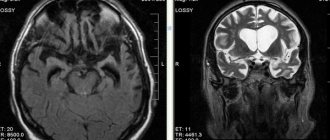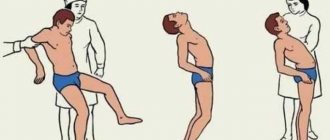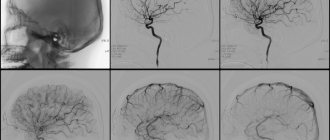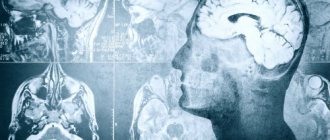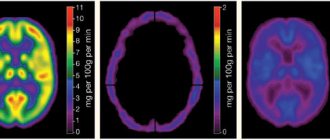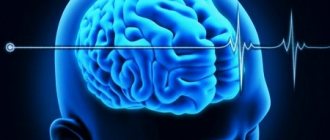Cortical atrophy of the brain is a devastating, irreversible change that most often affects people between 50 and 55 years of age, although there are cases of cortical atrophy in newborn infants. Pathological disorders, as a rule, manifest themselves in the frontal lobes of the brain, which are responsible for the thinking process, human behavior, and control. The disease progresses slowly with a gradual increase in the main symptoms, which ultimately leads to the emergence and development of senile dementia.
General information
Natural aging processes affect the state of the central nervous system. All older people experience memory deterioration and a decreased ability to learn, remember, and process information. In elderly and senile people, brain atrophy occurs (0.1-0.3% of volume is lost per year), associated with age-related physiological processes, but cognitive function does not quickly reach the level of dementia .
Therefore, in patients with a normal level of consciousness, the term “infectious changes” in the brain is often used. Physiological atrophy begins to develop at the age of 40-60 years and reaches severity by 75 years. In psychoneurological diseases ( Alzheimer's disease , Pick's disease , multiple sclerosis , Lewy body disease ), brain atrophy and, accordingly, neurological disorders progress quickly, leading patients to disability. With these diseases, from 0.5 to 1.4% of brain volume is lost per year. Atrophic changes in the brain, what is it? This is a decrease in the volume and density of brain tissue due to the death of neurons, which occurs for various reasons. Typically, atrophy is the outcome of long-term processes in which organic, irreversible changes in the parenchyma occur and nerve connections are destroyed.
In this case, atrophy of the cerebral cortex, subcortical structures (visual thalamus, limbic system, basal ganglia, hypothalamus) and atrophic changes in the cerebellum are observed to varying degrees. Cortical (or external) atrophy is observed in all patients with secondary atrophy. The changes can be generalized (the entire brain is affected) or local (specific areas of the brain are affected).
In some diseases, the white matter of the brain predominantly atrophies, while in others, the gray matter atrophies. Thus, in multiple sclerosis , atrophic changes in the gray matter occur in the early stages; they develop faster than white matter atrophy and are associated with cognitive impairment. As the volume of the cortex decreases, neurological changes progress. Women get sick more often than men and the first signs of pathology appear at 55 years of age. In this regard, it is important to carry out effective treatment that would reduce the rate of atrophic changes. This pathology cannot be cured and sooner or later ends in dementia .
The rate of atrophy determines the speed of onset and severity of disability.
How to help a patient
Malformation of cerebral vessels: what is it, types and signs, treatment and consequences
Cortical cerebral atrophy cannot be completely cured. The main task is to prescribe comprehensive treatment aimed at slowing the development of symptoms. Atrophies that appear at a young age can be effectively corrected if the etiological factor is excluded.
For the treatment of cortical atrophy, patients are prescribed drugs from the following groups:
- To improve blood microcirculation. The most popular drug is Trental. A drug with a vasodilating effect, increasing the lumen of capillaries, improving gas exchange through the walls of blood vessels and blood microcirculation.
- Nootropics. Drugs in this group improve blood circulation and brain metabolism. Highly effective drugs: Piracetam, Ceraxon, Cerepro, Cerebrolysin. Medicines in this group have a beneficial effect on the patient’s thinking abilities.
- Antioxidants. Drugs in this group stimulate regeneration processes, increase metabolic rate, slow down atrophy, and reduce the impact of oxygen free radicals.
- In order to relieve associated symptoms such as headache, the use of non-steroidal anti-inflammatory drugs is prescribed.
An important factor in the treatment of cortical atrophy is monitoring the patient’s neuropsychic state. This diagnosis should be accepted adequately by family members, as should their attitude towards the patient:
- the patient needs walks in the fresh air daily;
- moderate physical activity;
- the patient must be entrusted with all possible self-care procedures;
- in case of a neurasthenic state, the use of mild sedatives is permissible.
The disease progresses very quickly and the result of this process is personality degradation. The manner of communication, speech, and behavior takes on an ornate connotation. The vocabulary becomes significantly scarcer, which leads to the use of monosyllabic phrases in speech. The prognosis for patients with cortical atrophy of the brain is always unfavorable: whether the process progresses slowly or quickly, it always leads to degradation and, ultimately, death.
There are currently no effective methods for preventing the destructive process. The only thing that can slow down the process is:
- timely treatment of all existing diseases;
- active lifestyle;
- working on your memory;
- development of intelligence from youth;
- positive attitude.
In the article we will consider grade 1–2 cortical atrophy.
Injuries, hypoxia, age-related changes and other negative factors cause the development of atrophy of the soft tissues of the brain. Negative changes most often affect older people, but disturbances are also observed in newborns.
Pathogenesis
The development of atrophic processes in most cases is based on deterioration of blood supply. The cerebral cortex is gray matter. The white matter is located under the gray matter. The subcortical substance is formed by the thalamus, caudate and lenticular nuclei, and basal ganglia. It was found that the subcortical substance and the white matter of the hemispheres, located around the ventricles of the brain, are more affected by chronic cerebral ischemia than the gray matter. When cerebral vessels are damaged, the supply to the frontal subcortical areas is disrupted. Large areas of infarction develop in the white matter, in which axons and oligodendrocytes .
Damages to the cerebellum cause a decrease in its function: muscle contractions are discoordinated and it becomes impossible to perform normal movements in the limbs. The coordinated function of the muscles of the speech apparatus is disrupted, resulting in speech becoming slow and intermittent. Ataxia of the respiratory muscles is manifested by jerky breathing. Hypotonia of the tongue muscles causes soft consonants to be pronounced firmly.
Classification
Cerebral atrophy occurs:
- Primary. It is rare and is caused by genetic disorders and congenital brain abnormalities. It appears at any age, progresses quickly and cannot be corrected.
- Secondary. It is associated with the impact of adverse factors on the brain, among which are vascular pathology, traumatic brain injury, exposure to radiation, toxic effects, metabolic disorders, and bad habits. With secondary atrophy, eliminating the cause to some extent slows down the development of the disease, and adequate treatment ensures a stable condition for many years and a relatively good quality of life.
- General (the entire volume of the brain parenchyma decreases and the volume of the ventricles and subarachnoid spaces increases).
- Local (the volume of some brain structures decreases).
Depending on the location, there are:
- Cortical atrophy (the main symptom is the involution of the cortex in the temporal and frontal lobes).
- Generalized (changes in all parts of the brain).
- Multisystem (foci develop in several areas).
Depending on the stage:
- Stage I. Organic changes are minimal, but mild neurological disorders are noted. Emotional lability, memory impairment, and decreased concentration are noted.
- Stage II. Severe atrophic manifestations, which are manifested by hearing, speech and vision impairments. Behavior changes, a person commits illogical actions that he cannot explain and quickly forgets about them.
- Stage III. Cortical atrophy is sharply expressed and multiple foci are noted in the hemispheres. The patient cannot care for himself and needs outside help. Personal degradation is expressed to the maximum. This is how a person lives for many years until the destruction of important centers occurs and death occurs.
Cortical cerebral atrophy
This form is manifested by loss of intelligence and behavioral disturbances. The cerebral cortex (gray matter layer) is associated with higher cortical functions: perception, memory, imagination, thinking and speech. It has a complex six-layer structure and the neurons of each layer differ in function. Cortical areas, and accordingly, functions are divided into sensory, associative and motor.
Cortical atrophy occurs with the death of neurons in the frontal lobe cortex. The frontal association area is involved in higher mental functions. It controls behavior, logical thinking, object recognition and speech understanding. After damage to the frontal cortex apathy , there is no critical attitude towards oneself and one’s actions, the patient cannot use past experience, and his behavior becomes inadequate and unpredictable, he commits unmotivated actions. Cognitive (cognitive) abilities are gradually lost: the patient loses the ability to perceive, perceive information, analyze and remember it, and think. In general, cortical atrophy of the brain is characterized by progressive personality degradation, which occurs in stages.
Grade 1 cortical cerebral atrophy is the initial stage of the disease, in which there are no symptoms, but this conclusion can be given with MRI even in young people. At the same time, a person lives a full life and is active in his professional activities, but may periodically experience headaches , irritability and be emotionally unstable. Factors causing cerebral atrophy of the 1st degree may be various intoxications, previous traumatic brain injuries and deterioration of blood supply to the brain with osteochondrosis of the cervical spine .
Generalized atrophy
This is a common atrophy characterized by uniform death of areas of the entire brain. This form is characteristic of extensive ischemic and post-traumatic conditions, as well as neurodegenerative diseases - Alzheimer's disease , Parkinson's disease , Pick's disease and frontotemporal dementia. The progression of neurological symptoms depends on the degree of atrophy of the cortex and subcortical gray matter. Decreased cognitive function is associated with damage to the white matter and parietal cortex.
In this regard, generalized cerebral atrophy of the 2nd degree is characterized by a noticeable decrease in the patient’s ability to think and analyze. The level of critical thinking and evaluation of one's actions is reduced. The patient's habits, speech and handwriting also change. The person loses emotional connection and communication abilities. Neurological disorders - movements and coordination of movements - are more pronounced.
The third degree is characterized by degeneration of gray and white matter. The patient cannot control his behavior, and also needs care and observation, since there is a deterioration in hand motor skills and coordination of movements. The patient cannot use basic household items and is unable to make decisions independently.
Local degeneration is associated with:
- vascular diseases;
- alcohol abuse (atrophy of the cerebellar vermis is noted);
- multiple sclerosis;
- drug use;
- brain injury;
- infection of the central nervous system.
In the early stages of multiple sclerosis, the disease is characterized by degeneration of subcortical gray matter, most pronounced in the thalamus. After this, damage to the cortex develops (the central gyri are more affected), over time, destruction of the white matter is noted, and only then the spinal cord. In multiple sclerosis, not only general atrophy is observed, but also local atrophy - structures that have gray matter are affected: the cerebellum , basal ganglia and thalamus . In multiple sclerosis, gray matter atrophy predominates over changes in white matter, and it determines the degree of disability of patients.
Cerebellar atrophy
The cerebellum is located below the hemispheres and above the brain stem. This formation coordinates movements and their precision, receiving information from the cortex and basal ganglia about the position of the legs. Cerebellar lesions are characteristic of multiple sclerosis , Friedreich's ataxia , olivopontocerebellar degeneration , Pierre-Marie's ataxia . Ataxia (meaning disorder) is a characteristic feature of lesions of this brain formation.
Friedreich's ataxia appears at 10-20 years of age. Patients develop weakness in the legs, falls, staggering and uncertainty when walking, handwriting, speech and hearing are impaired. Muscle atrophy gradually increases (at first it is expressed in the legs, and over time it also covers the arms), deep sensitivity is impaired, cataracts develop, the optic nerve atrophies, and dementia develops. Computed tomography for this disease is ineffective, since a weak degree of atrophy of the hemispheres and cerebellum, expansion of the cisterns, and ventricles is detected in the later stages. Olivopontocerebellar atrophy is considered a form of multiple system atrophy.
Multiple system brain atrophy
This is a variant of a degenerative progressive pathology of the brain, which affects the basal ganglia, cerebellum and centers that are responsible for autonomic reactions. Clinically, multiple system atrophy is manifested by parkinsonism , cerebellar ataxia and autonomic disorders . The disease appears at the age of 50-60, progresses rapidly and leads to death. The muscles become stiff, the patient has difficulty moving, coordination and function of internal organs are impaired.
Depending on the predominant syndrome, the following forms of the disease are distinguished:
- Striatonigral degeneration or parkinsonian form . With it, degenerative changes are most pronounced in the striatum (belongs to the basal ganglia) and the substantia nigra (part of the extrapyramidal system, which plays a role in motor function). The leading symptom is parkinsonism .
- Olivocerebellar atrophy or cerebellar form . The cerebellum, olives and pons are affected. In the clinic, cerebellar syndrome predominates, manifested by impaired coordination and inability to maintain balance.
- Shy-Drage syndrome . In this form, the leading ones are autonomic failure and orthostatic hypotension - in patients, the pressure sharply decreases and a pre-fainting state appears when moving to a vertical position. Patients are also concerned about decreased sweating, darkening of the eyes, urinary disorders, impotence and unsteady gait.
Treatment with folk remedies
Through herbal remedies, the intensity of the negative manifestations of grade 1 cortical medullary atrophy can be reduced.
Good results will be obtained thanks to the following recipes:
- herbal tea - take motherwort, oregano, horsetail and nettle in equal proportions and brew with boiling water in a thermos; the decoction should be infused at night and drunk three times a day;
- chickweed and rye are brewed in a thermos; it is drunk in unlimited quantities after meals; This tea is especially good for treating post-traumatic areas;
- rosehip, viburnum and barberry - the berries of these plants should be poured with boiling water and left for eight hours; You can drink it like tea in any quantity; If necessary, you can add honey.
Causes
Cerebral atrophy in most cases is secondary in nature and it is worth noting the reasons that lead to this condition:
- Genetic predisposition.
- Chronic cerebral ischemia , causing diffuse damage to the white matter (cerebral atrophy), against which vascular dementia develops. It should be noted that cerebral atrophy in vascular dementia is not very pronounced when compared with Alzheimer's disease , and hippocampal atrophy in chronic cerebral ischemia is the same as in Alzheimer's disease.
- Arterial hypertension hypertensive encephalopathy develops . With this disease, MRI reveals multiple changes in the subcortical zones around the ventricles (leukoaraiosis), cortical atrophy and dilatation of the ventricles. The same changes are observed during physiological aging.
- Antiphospholipid syndrome.
- Central nervous system infections ( meningitis , polio , leptospirosis ).
- State of decortication in coma .
- Atherosclerosis general and cerebral. The condition worsens when atherosclerosis is combined with arterial hypertension.
- Brain tumors.
- Embolism of the cerebral arteries. The source of embolism is fragments of atherosclerotic plaques and blood clots from the heart.
- Atrial fibrillation . In patients with fibrillation, the brain matter as a whole, as well as individual parts, decreases. The frontal regions of the brain and hippocampus are primarily affected.
- Congenital anomalies of cerebral vessels, causing cerebrovascular disorders.
- Blood rheology disorders (increased viscosity, platelet aggregation, etc.).
- Elevated homocysteine . Homocysteine is a sulfur-containing amino acid, an increase in the level of which is associated with the development of vascular disorders of the brain and heart and neurodegenerative processes in the brain. Hyperhomocysteinemia is a risk factor for recurrent strokes and white matter changes. Patients with elevated homocysteine levels have greater hippocampal atrophy.
- Diabetes . Patients with diabetes mellitus are characterized by mild cerebral atrophy of the cortex, subcortical structures and leukoaraiosis . Even an increase in glucose to the upper limit is associated with atrophic changes in the hippocampus and amygdala complex.
- Multiple sclerosis . Already in the early stages, patients experience degenerative changes - neurons and axons die. Axonal damage is observed in active and chronic lesions of sclerosis. In the latter, axon density decreases to 80%. These processes, plus gliosis and demyelination, lead to a decrease in brain volume. Patients with relapsing-remitting sclerosis (it occurs with exacerbations and remissions) lose 0.5-1.3% of brain volume per year.
- Alzheimer's disease . MRI reveals atrophy of the temporal lobe (reduction in the volume of the gyri and widening of the sulci) and hippocampus, which are markers of this disease. The hippocampus plays an important role in memory formation (categorization of information and long-term memory). Any traumatic brain injury accelerates the development of Alzheimer's disease.
- Any intoxication of the body (drug, alcohol, drugs). With alcoholism, diffuse brain atrophy develops.
- Age-related changes.
- Hydrocephalus in children. This pathology is accompanied by structural changes in the brain: thinning of the cortex, reduction of white matter, vascular atrophy and atrophy of the basal ganglia and cerebellum.
- Traumatic brain injury . 3-4 weeks after the injury, minor hemorrhages resolve, the ventricles and subarachnoid space expand, and generalized brain atrophy develops, which is caused by prolonged intracranial hypertension.
- Long-term corticosteroid therapy can cause cerebral atrophy.
- Acute pain. Acute pain that persists for 3 months causes atrophic changes in the cerebral cortex.
- Physical inactivity . A risk factor for the appearance of atrophic processes and a decrease in cognitive cognitive functions is the limitation of physical activity.
Symptoms of brain atrophy
The initial symptoms of the disease reflect changes in the mental state of patients. Early symptoms are anxiety and depression . Patients become apathetic, lethargic, they are not interested or attracted to anything, they prefer to retire and constantly stay at home, their night sleep is disturbed. The mask of depression is irritability, dissatisfaction with everything and grumpiness, which are regarded as characteristics of older people.
If depression is a marker of internal atrophy, then anxiety disorders are characteristic of focal and external cerebral atrophy.
Cognitive disorders (memory, attention, concentration, ability to recognize objects and perform actions purposefully) are detected in all patients in the early stages of brain degeneration. Cognitive symptoms and depression are often regarded as senile forgetfulness and low mood. Impaired memory and attention first occur against the background of maintaining professional and everyday skills. As it progresses, social skills are gradually lost (the patient cannot independently go to the store, pharmacy, or visit the clinic, since he lacks purposefulness of actions) and household skills (he cannot simply take care of himself, eat and take a shower). Over time, sloppiness appears, the vocabulary becomes poor, the patient does not comprehend the speech and requests addressed to him. His movements are sweeping, his handwriting changes and his fine motor skills deteriorate.
In severe cases, the patient does not recognize his relatives and friends, cannot navigate the place and cannot answer questions. The specific behavior is that patients constantly repeat actions and words after others. The final stage of brain degeneration is marasmus - complete regression of mental abilities and destruction of personality. At the same time, infant reflexes are activated: a sucking reflex appears, the patient lies in the fetal position, recovers and urinates under himself. He responds to calls with inarticulate sounds.
Symptoms of cerebellar atrophy
Since the cerebellum regulates movements, if it is damaged, the following will be observed:
- Balance and muscle tone problems.
- Gait disturbances (wide-spaced legs, unsteadiness, difficulty turning).
- Fine motor disorders.
- Uncoordinated movements of arms and legs.
- Unsteadiness and frequent falls.
Patients are also worried about headaches , dizziness , attacks of nausea and vomiting, visual disturbances, pronunciation problems, scanned and slow speech, uncoordinated eye movements, and decreased hearing acuity. As it progresses, urinary incontinence , paresis and paralysis .
The role of a positive attitude
Most experts agree that a calm atmosphere, the right attitude and participation in all daily activities have a positive effect on a person’s well-being. The patient's relatives need to take care that there are no violations of the daily routine.
A positive attitude, active life and lack of stress are the best ways to stop the disease.
The following factors help prevent degenerative phenomena:
- healthy lifestyle;
- healthy eating;
- giving up bad habits;
- constant mental activity;
- blood pressure control.
Treatment of grade 1 cortical atrophy should be timely.
Tests and diagnostics
When examining a patient, psychodiagnostic examinations are used - tests, Schulte tables, MMSE mental status assessment scale, memorizing 10 words, etc.
- An MRI scan of the brain is also used. MRI is more effective at detecting local changes. Characteristic signs of atrophy are widening of the grooves (cortical atrophy) and enlargement of the ventricles. Based on this, the cerebroventricular index (the ratio of the size of the ventricles to the transverse diameter of the brain) is calculated. With this pathology, MRI reveals: an increase in CVI; expansion of subarachnoid spaces; white matter degeneration; decreased tissue density; reduction in shares in size. Based on the study, a quantitative assessment of atrophy is made. In generalized cortical atrophy, sulcal and ventricular widening is assessed in 13 different areas. Certain diseases are characterized by certain changes: with Pick's disease, atrophy is expressed in the frontal and temporal regions. In Huttington's disease , changes in the heads of the caudate nuclei. Parkinson's disease is accompanied by generalized atrophy and atrophy of the substantia nigra, and in Alzheimer's disease - atrophy of the hippocampus.
- The Fazekas scale evaluates quantitative white matter damage. The score on this scale has prognostic value. If the total score is 3, then the patient loses the ability to care for himself and live independently within a year: 0 - no leukoaraiosis; 1— multiple point lesions; 2 - moderate leukoaraiosis, with a tendency to merge; 3 - severe leukoaraiosis (“confluent”).
- Doppler ultrasound. Detects vascular patency.
- Electroencephalography (studies the degree of brain activity).
- Rheoencephalography (studies the state of blood circulation in the brain).
- Angiography (radiography of blood vessels with a contrast agent).
- Blood pressure monitoring and ECG monitoring if indicated.
- Ophthalmoscopy.
- Biochemical blood test.
Diet
Mediterranean diet
- Efficiency: from 2 kg in 7 days
- Terms: from 7 days
- Cost of products: 4000-6000 rubles for 7 days
Diet for Parkinson's disease
- Efficacy: therapeutic effect after a month
- Timing: constantly
- Cost of food: 1600-1700 rubles per week
In addition to drug maintenance treatment, it is important for patients with beginning signs of degenerative age-related processes to follow a diet. The Mediterranean diet has been proven to have a neuroprotective effect and prevent the development of cognitive impairment. Its features are a large amount of vegetables, fruits, fish (at least 3 times a week), which should replace meat, whole grain products and vegetable oils rich in ω-3 PUFAs (flaxseed, rapeseed) and ω-9 PUFAs (olive).
For problems with the cardiovascular system, the patient should receive 1 g of ω-3 PUFAs daily from fatty fish (salmon, herring, mackerel), nuts and flax oil. Mackerel has the highest omega-3 content (2299 mg per 100 g), followed by salmon (1966 mg) and herring (1571 mg). Depending on the type of fish, 50-80 g of it contain the daily requirement of 1 g of ω-3 PUFAs, and a handful of walnuts - 2.5 g of omega-3.
Flaxseed oil is a source of alpha-linolenic acid , from which eicosapentaenoic and decosahexaenoic acids are formed in the body. It is useful to consume not only flax oil, but also whole flax seeds, which contain fiber and phytoestrogens . Other sources of omega-3 include broccoli, melon, cauliflower, canola oil, beans, spinach, and Chinese cabbage.
In addition, it is better to replace omega-6 fatty acids (sunflower oil and soybean oil) with omega-9 - oleic acid found in olive oil. High doses of antioxidant vitamins (vitamins C and E) have been proven to be beneficial for the restoration of vascular endothelium. Flavonoids in red wine, red grapes and chocolate improve endothelial function in large arteries.
Prevention
There is no specific prevention, but following generally accepted recommendations for a healthy lifestyle can to some extent prevent or reduce the severity of degenerative changes in old age.
- Full sleep.
- Physical activity. Sufficient activity in old age has a positive effect on brain function and slows down age-related changes. Individuals with high activity exhibit less atrophy—less damage to white matter and greater volume of gray matter.
- Sufficient intellectual activity.
- Maintain a diet rich in antioxidants, vitamins and omega PUFAs. The results support the possibility of effective use of fish oil in reducing cognitive ability in the elderly and in Alzheimer's disease. Often cognitive impairment is associated with a deficiency of folic acid and vitamin B12 .
- Quitting the use of alcohol and drugs.
- Elimination of risk factors (high blood pressure and blood sugar levels, lipid metabolism disorders, anxiety, depression, sleep disturbances).
- Timely treatment of initial cerebrovascular disorders.
- Prevention of head injuries and infections of the nervous system.
- Genetic counseling for people with a family history of Alzheimer's disease .
- To prevent hydrocephalus in children, which causes brain atrophy, it is important to promptly identify and treat infections in pregnant women.
Purchased
Cerebral ischemia: why it develops and why the pathology is dangerous
There are also acquired reasons. Brain atrophy can occur from:
- Drinking alcohol and smoking. This causes cerebral vascular spasm, resulting in oxygen starvation. Because of this, white matter cells cannot receive enough nutrients, causing them to die.
- Infectious diseases that affect nerve cells - meningitis, rabies, polio.
- Injuries, concussions and mechanical damage.
- Severe form of renal failure. This causes general intoxication of the body, which causes metabolic disorders.
- Hydrocephalus disorders. This phenomenon manifests itself in an increase in the subarachnoid space and ventricles.
- Chronic ischemia, which leads to vascular damage and low supply of nutrients to neural connections.
- Atherosclerosis, which manifests itself in a narrowing of the lumen of veins and arteries, which increases intracranial pressure and creates a risk of stroke.
Atrophy of the cerebral cortex can occur due to insufficient intellectual and physical activity, lack of a balanced diet and poor lifestyle.
Forecast
The prognosis for cerebral atrophy is unfavorable, since this pathology is not treated, progresses and is associated at first with a decrease in the quality of life, and then with disability. Irreversible changes in the brain lead to a decrease in intelligence to the point of mental retardation. Cerebral atrophy does not always reduce life expectancy, but significantly worsens its quality. Life expectancy with cerebral atrophy depends on the degree of damage and the rate of progression. With rapid progression and involvement of vital centers, life processes may stop.
Life expectancy with multiple system atrophy is significantly reduced as bulbar palsy , a swallowing disorder, progresses rapidly. Dysphagia is complicated by aspiration of food and pneumonia , often leading to death. asphyxia occur .
What should the patient's family do?
The disease progresses and the patient requires care.
The first to appear are problems with swallowing liquid or solid food, independent movement and control of urination and defecation are impaired. Relatives of the patient may encounter the following problems:
- Registration of a disability group;
- Receiving social assistance;
- Finding patient care information.
You can assign the patient to a nursing home, where qualified staff will care for the patient. Boarding houses for people with this disease operate on a paid basis; a day’s stay costs from 1,500 rubles.
Link to a European support group for patients with MSA, as well as stories from the lives of patients in Russian and other languages.
List of sources
- Lokshina A. B., Zakharov V. V. Mild and moderate cognitive impairment in dyscirculatory encephalopathy. //Neurologist. magazine – 2006. – T.11, appendix.1. – P.57 – 64.
- Vorobyova O. V. Chronic cerebral ischemia: from pathogenesis to therapy (recommendations for an outpatient neurologist) // RMJ “Medical Review” No. 5, 2021. - P. 26-31.
- Golubev V.L., Vein A.M. Neurological syndromes: a guide for doctors. 6th ed. – M.: MEDpress-inform, 2021. – 736 p.
- Ekusheva E.V. Clinical portraits of “typical” patients in neurologist practice. Consilium Medicum. 2019; 21(9): 131-135.
- Odinak M.M., Voznyuk I.A. Neurometabolic therapy for pathologies of the nervous system. Emergency medicine. 2013; 3(50): 72-77.
